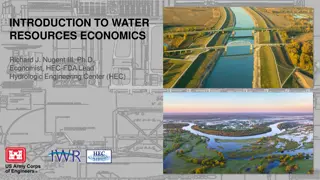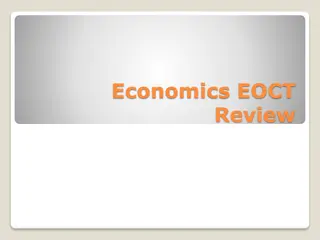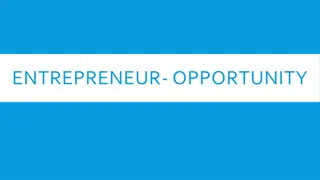Understanding Scarcity in Economics: A Tutorial Overview
Explore the concept of scarcity in economics through a comprehensive tutorial covering key principles such as resource allocation, human wants, economic problems, and the necessity of economic analysis due to limited resources. Gain insights into the art and science of economic analysis in relation to scarcity and decision-making.
Uploaded on Oct 06, 2024 | 0 Views
Download Presentation

Please find below an Image/Link to download the presentation.
The content on the website is provided AS IS for your information and personal use only. It may not be sold, licensed, or shared on other websites without obtaining consent from the author. Download presentation by click this link. If you encounter any issues during the download, it is possible that the publisher has removed the file from their server.
E N D
Presentation Transcript
Multiple Choice Tutorial Chapter 1 The Art and Science of Economic Analysis 1
1. When is a good or service scarce? a. it is rare and hard to come by. b. there is not enough of it available for everybody who wants it for free. c. there is plenty available for everyone who wants it. d. there is a shortage. B. Scarcity means that there is not enough of something so that everyone who wants it cannot have it for free. In this case, how do we decide who gets? Everything that is scarce will have a price, the price determines who gets and who does not get. 2
2. Human wants and desires are a. eventually satisfied in any society b. constant from one time period to the next c. virtually unlimited d. limited and scarce C. In our analysis of economics we assume that when given a choice, people would want more rather than less. Each time people make a choice between alternatives, the choice made is the one that they believe will increase their total welfare. 3
3. Scarcity is an economic problem a. only in capitalist economies. b. only in command economies. c. only in poor countries. d. in every country and in every household. D. The only way not to have scarcity is for everyone to have everything they want for free, an impossible situation. 4
4. Economic analysis would be unnecessary if there were no a. taxes b. government c. scarcity d. money C. All of economic analysis revolves around the fact that we live in a world of scarce resources. Therefore, the problem becomes, how do we meet people s wants and needs in this world of scarcity? 5
5. Because resources are scarce, a. opportunity costs are zero b. people must make choices among alternatives c. all human wants and desires can be satisfied d. resource prices are flexible B. No matter what economic system people live in, all people s in every society are faced with the problem of scarcity. 6
6. Economics deals with the problems caused by a. scarce resources and unlimited wants. b. scarce resources and limited wants. c. abundant resources and unlimited wants. d. abundant resources and limited wants. A. No matter what political system people live under there will always be people who want more than the economy can provide them for free. 7
7. Resources are divided into the following broad categories: a. men, money, and machines. b. saving, spending, investment, and capital. c. human, technological, and government. d. land, labor, capital, and entrepreneurial ability. D. The four resources to grow an economy are land, labor, capital, and in a free market, entrepreneurship. In a command system, the fourth resource would be the government. 8
8. In economics, land refers a. only to plots of ground on the surface of the earth. b. to the specific area of the earth in a country or region. c. to rural regions as distinguished from urban areas. d. to any and all natural resources. D. A land resource is anything from the earth. Some examples of a land resource are: timber, fresh water, fertile land, copper, iron ore, gold, silver, and anything else that can be used from the earth that can be used to produce goods and services. 9
9. Physical and mental human effort is defined in economics as a. labor b. manpower c. productivity d. performance A. The labor that we are talking about here is directed and productive labor. Labor that is directed to the production of goods and services helps build a productive economy. 10
10. Labor is ultimately derived from a. capital b. technology c. natural resources d. time D. This is particularly true when it comes to skilled labor. It takes time to acquire the knowledge and skills to be productive in this high tech economy we live in. 11
11. In economics, capital refers to a. money. b. stocks, bonds, and other financial assets. c. the seat of government. d. machines, buildings, and tools. D. Capital are those resources which can be used to produce goods and services. 12
12. Which of the following is not an example of capital ? a.the copy machine which duplicated this exam b. an economics professor s knowledge of economics c. the building in which this class is located d. the amount of tuition which you paid for this class D. The copy machine and the school building are tangible things used in the productive process. The economic professor s knowledge is what we call human capital, the knowledge necessary to work with capital. But the tuition you pay is neither capital or human capital. 13
13. An entrepreneur is a. an intermediary between buyers and sellers in the marketplace. b. the organizer who seeks profitable opportunities and is willing to accept risks. c. a business organization involved in using inputs to produce output. d. the administrator who runs an enterprise without accepting any risk of financial loss. B. Someone has to decide what and how to produce goods, in a command economy it is the government, in a free market, it is the entrepreneur. 14
14. Managerial and organizational skills are categorized as a. physical capital b. technological ability c. entrepreneurial ability d. human labor C. Anyone can be an entrepreneur, it does not necessarily take a lot of money. Entrepreneurship is an attitude more than anything else. If you have dreams of owning your own business and have a plan to start and and develop that business into a profitable venture, and take action on your dreams, you are an entrepreneur. 15
15. Payment for the use of natural resources in a production process is called a. rent. b. wages. c. interest. d. profit. A. When a person lets someone use their land, the payment they receive is called rent. 16
16. Payment for the use of financial capital in a production process is called a. rent. b. wages. c. interest. d. profit. C. Financial capital is money used to purchase capital. The return a persons can make when they lend someone this money to purchase capital is called interest. The same is true if the capital itself was lent out. 17
17. In a production process, profit is the payment received by the a. capital. b. labor c. technology. d. entrepreneur. D. The reward to someone to take risks in a business venture is called profit. 18
18. Profit is also known as a. rent b. mark-up c. the monetary aggregate d. the residual claimed by the entrepreneur D. Residual is that which is left over. When one tallies up the total revenue and the total costs as a result of a business venture, if there is something left over, that something is called profit. If there is a deficit, a loss is incurred. 19
19. Unlike a service, a good a. is desirable b. uses resources to satisfy wants c. is physical and tangible d. is abundant and free C. The word good is a term economists use to signify something physical and tangible that is useful. 20
20. Goods and services which are considered free a. are the most important topics for economic analysis b. are produced at no cost to society or the the individual c. usually involve some real opportunity cost d. are undesirable C. Each time a choice is made an opportunity costs is incurred. To do one thing, even if it involves a free good, something else has to be given up. Even if you drink water from a drinking fountain, you cannot drink a soda pop at the same time. So the soda pop that you did not drink is an opportunity cost. 21
21. Households a. own and sell resources b. play a very minor role in the economy c. produce goods and services d. none of the above A. A home is an example of this. People can own everything that can go into a house. Households can sell the house and everything in the house. 22
22. Goods and services are exchanged in a. product markets. b. resource markets. c. inventory markets. d. classified markets. A. Consumers buy products in retail stores. Therefore this market is called the product market. Business buy goods and services in the resource market. The resource market is where land, labor, and capital are exchanged. 23
23.The labor market is an example of a a. government market. b. classified market. c. communication market. d. resource market. D. Labor is one of the four resources. The market that labor is bought and sold is therefore called the resource market. 24
24. The economic behavior of individual decision makers and the determination of price and output in specific markets are both studies in a. microeconomics. b. macroeconomics. c. positive economics. d. normative economics. A. Microeconomics is the study of the decision making process of economics. 25
25. In macroeconomics, we analyze the a. all of the following. b. overall performance of the economy as a whole. c. arrangements through which specific products are exchanged. d. influences on the decision making of particular households. B. Macroeconomics is the study the economy in the large, it s like if you were flying over the economy and able to see how all the different parts fit together. 26
26. The assumption of rational self-interest means that economic decision makers a. have no concern for the welfare of others. b. consider the welfare of others to be more important than their own happiness. c. know with certainty which choice will have the best result. d. make reasonable decisions based on their expectations of results. D. In order to make predictions as what people will do when faced with choices, we have to assume that they will act rationally. 27
27. In economics, the term marginal refers to a. a change in an economic variable. b. a low quality product or resource. c. an unimportant and irrelevant economic variable. d. all-or-nothing economic decisions. A. Marginal is the last increment or the last unit of something. Marginal product, for example, is the amount of money brought into a business by selling the last unit of output. 28
28.Rational economic decision makers will make a change only if a. the change is free of risk b. there are no costs involved c. their expectations are correct d. expected marginal benefit exceeds expected marginal cost D. Marginal benefit is measured by how much benefit one receives from the last act; marginal cost is a measure of the cost of that last act. One will chose to do something if the marginal benefit of the last act is greater than the marginal cost of that last act. 29
29.When economic choice involves adjustment to the existing situation, marginal analysis a. has no practical applications or real-world uses. b. eliminates incorrect decisions and bad choices. c. means comparing the additional costs and additional benefits of an activity before deciding. C. People make decisions based on the margin. For example, a person will buy a soda pop only if the expected pleasure received is greater than the value placed on the money that has to be given up to purchase the drink. 30
30. Economic information a. is scarce and costly to acquire b. is available for free to any decision maker c. is not required for rational decision making d. must be complete before any decision is made A. The government and businesses spend an enormous amount of resources on acquiring information. 31
31. An economic model is useful only if it a. includes every detail of reality b. makes no unproven assumptions c. is mathematical, and is expressed in equations d. makes accurate predictions D. An economic model is a picture of a series of events. It portrays a simplification of reality and is used to make predictions about the real world. The purpose of the model is to help us understand what is and what the results will be as certain variables change. 32
32. The scientific method is useful a. only in fields of science such as chemistry and physics b. for testing the validity of theoretical predictions c. for testing the validity of a model s assumptions d. when no economic variables can be assumed to be constant B. The four steps to the scientific method are: identify and define the key variables, specify the assumptions, formulate an hypothesis, test the hypothesis. 33
33. The ceteris paribus assumption means a. after all other changes have been taken into consideration . b. all economic decision makers behave according to rational self-interest . c. marginal benefit equals marginal cost d. holding all other variables constant . D. Economists can make predictions only if one variable changes and everything else stays the same. For example, people will buy more Cadillac cars when the price goes down, assuming that their incomes or the price of other luxury cars do not change. 34
34.A hypothesis is a. an assumption about behavior b. useful only if the assumptions are realistic c. useful in microeconomics, but not in macroeconomics d. a prediction of what will occur, given certain assumptions D. In any theory, the accuracy of the theory is predicated upon the assumptions made. If the assumptions are not truthful, one s conclusions will be incorrect. 35
35. A model which sometimes makes incorrect predictions will be used by economic decision makers a. under no circumstances b. only if its assumptions are detailed and realistic c. if it is mathematical and computerized d. until a better model is developed D. As events and conditions change in the real world, so it is necessary to refine economic models. Otherwise the models will not portray the real world. 36
36. Economic theory is designed to a. express normative values b. invent an imaginative and interesting story c. predict the behavior of a specific economic decision maker after an economic change d. predict the average behavior of a group of similar economic decision makers after an economic change D. There are always exemptions to the rule. In economics we are interested in what is true most of the time for the majority of people. 37
37.The difference between positive economic statements and normative economic statements is that a. positive statements are based on opinion and normative statements are based on fact. b. positive statements are true and normative statements are often false. c. positive statements are based on fact and normative statements are based on opinion. C. Positive economics is the study of what actually happens. For example, to predict that people will buy more Cadillac cars when the price goes down is an example of positive economics. To say that people should not waste money on luxury is normative economics. 38
38. If one were to commit the association-is- causation fallacy, one would conclude that a. an event which follows another event was caused by the first event. b. an event which follows another event was not necessarily caused by the first event. c. the simplest model is the best predictor. d. what is true for the individual is also true for the group. A. If you were raised on a farm and as a youth you believed the rooster growing caused the sun to come up everyday, you would be guilty of the association-is-causation fallacy. 39
39. If one commits the fallacy of composition, it is likely that the individual is assuming a. the simplest model is the best predictor. b. an event which follows another event was caused by the first event. c. an event which follows another event was not necessarily caused by the first event. d. what is true for the individual is also true for the group. D. If you were at a football game, it is true that you will get a better view if you stand up only if everyone else does not stand up at the same time. 40
40.The secondary effects of a policy are a. unintended consequences, which may be undesirable b. intentional and desirable, but require more time to take effect than the primary effect of the policy c. unimportant and should be ignored by policy makers d. immediately obvious to decision makers A. When building an economic model and making the assumptions, it is always possible that not everything germane to the situation is considered. Or, if considered, it is not considered in the correct way. 41
END 42























